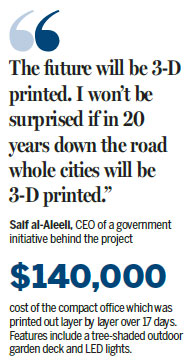Futuristic Dubai office showcases 3-D printing's potential
Six-meter tall printer squirts out cement and other materials to produce 17 modules
There are office printers that spit out documents and others that always seem to jam. And then there are those that make the office itself.
A small group of employees in Dubai is starting to move into a new workspace that the emirate said is the world's first functional office building made using three-dimensional printer technology.
Dubai's ruler quietly inaugurated the whitewashed buildings last week, not far from the site of a planned Museum of the Future that is due to open in 2018.
Looking like a mashup of a "Jetsons" abode and an Apple Store, the compact office was printed out layer by layer over 17 days at a cost of $140,000, said Saif al-Aleeli, the CEO of a government initiative called the Dubai Future Foundation that is behind the project. Features include a tree-shaded outdoor garden deck and LED lights that automatically adjust to the brightness outside.
"Why 3-D printing? Because it makes sense in terms of cost, in terms of timesaving, in terms of efficiency," the 29-year-old al-Aleeli said. "We really believe that this technology will revolutionize the construction, the development sector as well as other sectors, (including) the medical sector (and) consumable products."
Products made using 3-D printing are first designed on a computer and then printed out using a variety of materials, including metal, plastic and concrete.
Developers are finding a growing number of uses for the technology as it evolves.
European aeronautics giant Airbus just unveiled a lightweight electric printed motorcycle made from aluminum alloy particles, while a Wisconsin schoolteacher recently fashioned prosthetic feet for a duck who lost his due to frostbite.
The technology has been used in other construction projects too, including a Dutch canal house being raised in Amsterdam. But the foundation said its Dubai office is the first "fully functional 3-D printed building", constructed with full services and meant for daily use.
Ambitious goal
The Chinese company WinSun Global used a 6-meter tall printer squirting out cement and other materials to produce the 17 building modules for the new Dubai office. The pieces were then shipped from China to the Gulf port city, where it took workers two days to piece them together.
Further work, including the installment of the interiors and landscaping, took another three months. Designers left open part of the finishing in the foyer so visitors can see how the 3-D printed layers came together, row after squiggly row.
The building occupies prime real estate between the city's iconic twin Emirates Towers and the Dubai International Financial Center, which is a stand-in for a futuristic city in the forthcoming Star Trek Beyond film.
The site will serve as the temporary offices for between 12 and 20 foundation staff members for now. Dubai hopes it will kick-start its plans to transform the sheikhdom into an incubator for emerging technologies. It has an ambitious goal of using 3-D printing in a quarter of all buildings by 2030.
"The future will be 3-D printed," al-Aleeli predicted. "I won't be surprised if in 20 years down the road whole cities will be 3-D printed."

(China Daily 06/02/2016 page11)














